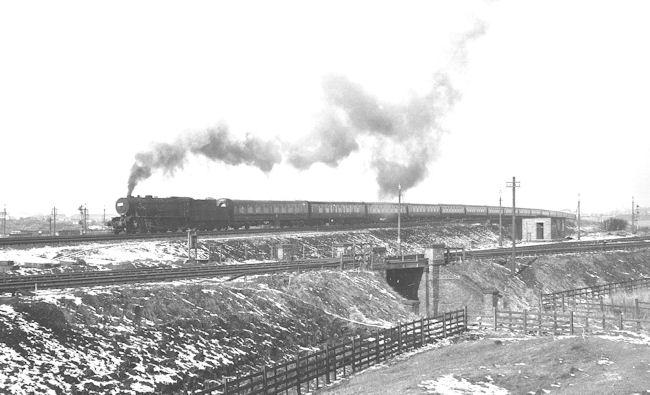Wigan Album
Railway
7 Comments
Photo: Thomas Sutch
Item #: 6652
Looking at that Thomas, it is an excursion with the numbered board on the smoke box door, also there are at least 15 coaches on that train, quite a weight to be pulling.
I am 99% sure this is an empty stock train.The engine is a WD type 2-8-0 and it is very unlikely this basic, some would say crude, design would be used on a passenger train.
Imagine the length of the platform
I presume the lines in the foreground form the start of the Whelley Loop?
It is Steve. This was the last bit of the Whelley line story really, identified on maps as the “Platt Bridge Junction line. At some point (but certainly by the late 1880’s when the quadrupling through to Wigan was completed) the LNWR built the later section of line from Amberswood West Jct. (where it leaves the original 1869 Whelley Line) round to Bickershaw Jct.
This piece of line wasn’t then part of the original Whelley line as built, but a later LNWR addition to enable goods trains to access various collieries, the marshalling yards/sidings at Bamfurlong, other industry; and also of course allow light engines to access The Springs Branch Motive Power Depot.
In order to access the Springs Branch Depot and the Bamfurlong Goods lines which ran between Bickershaw Jct. and Wigan South Jct. etc off the WCML it was necessary for trains to burrow under the WCML at Bickershaw Jct., to avoid crossing the busy main lines on the level from the Down Slow to the Goods lines side. These Bamfurlong Goods lines are still in situ, as is the “goods line flyover bridge”, which is immediately behind the small brick building in our picture and in regular use, even in today’s pale shadow of itself railway!
The problem for the LNWR was that if you wished to travel either on or off the Whelley line your only access at the south end involved a pretty heavily graded and tightly curved approach plus the two Junctions at Bamfurlong Sorting Sidings and then Bamfurlong (main lines) junction. This could never be conducive to good running even with a slow timed goods train. Additionally, the LNWR had long been using the Whelley line as a WCML diversion path - very often for passenger services as well as freight. Even if you were coming “down grade” from Roundhouse or Lindsey pit, you still had to slow to a walking pace as you approached the junctions to ensure you “!had the road” before proceeding. No continuous brake then remember, and certainly no air brakes like now!”
The solution in the about 1887 or so (I think) was to build the short section of track that you see in the picture above, which left the Platt Bridge Jct. line shortly after passing under Warrington Road and more or less opposite the old CWS works and which then curved round to run parallel to the Up Fast line on the main line and then to re-join the WCML at Bamfurlong Jct. This enabled much faster running than could be carried out before without having to drop down under the WCML and then climb back up to it on the Down Slow side and cross over the running lines. Additionally you didn’t have to “stitch” the whole junction up to re-join the main line as you did before!
In the modern railway, I am afraid that many railway managers (a great many of whom have little experience of the operation of a major railway before working there) like to think that they know a thing or two about running said railway! Unfortunately they could not, in my opinion, come remotely close to holding a candle to the men who devised, planned and executed the sort of set-up we see on the Whelley line, both here at Bamfurlong and of course at the Douglass valley end with a huge scissor style junction between Red Rock/Standish/Boards Head and Whelley Junctions.
That's a very informative piece Dave.
thanks for that.
seen plenty of wd,s on excursion trains ,but do agree with the emptystock movement,strong but not very well liked.